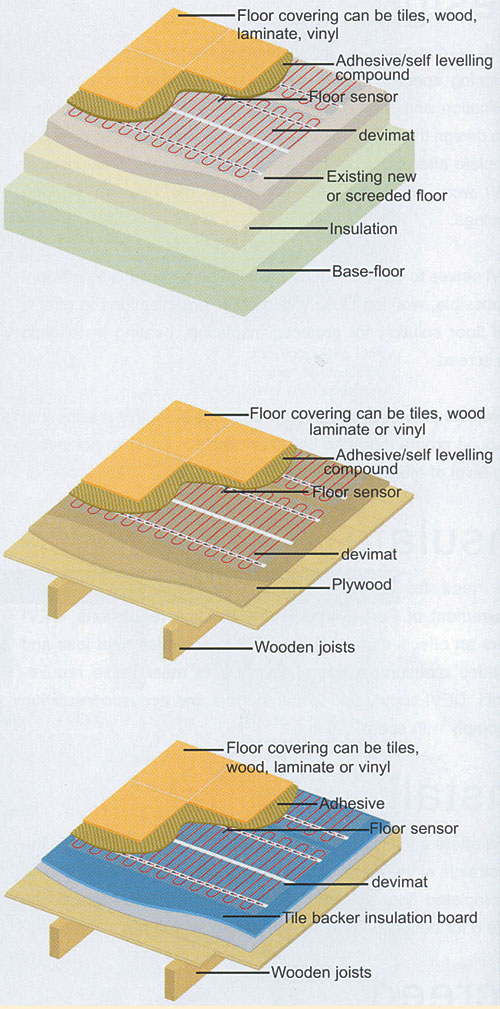home > carpet news > product knowledge > underfloor heating
Product knowledge:
Electric Underfloor Heating
Reproduced with kind permission of Carpet and Flooring Review
Electric underfloor heating is an energy efficient answer in both commercial and residential application and there is plenty of advice on hand from suppliers to sell its benefits, explains Adam Groves of Devi.
There are two main types of electric underfloor heating (UFH) product: cables and mats. Cables come in two versions – a single conductor with two cold tails, and twin conductor with one cold tail – with specification according to floor construction. Mats are selfadhesive mesh with ultra-thin, twin conductor heating cables attached. Among many accessories, controls are important. The most ‘intelligent’ offer thermostat and timer functions and can monitor floor or room temperature or both. Adjusting automatically to changing weather conditions, they ‘learn’ from their environment and maximise efficiency while minimising running costs. UFH, particularly electric, has many advantages over other heating systems. It provides even, quiet, invisible, radiated heat across entire floor areas. Convection from wetsystem or storage radiators or panels creates more air currents which carry more particulates to make walls dirty and affect people with allergies. No wall space is taken up which offers greater freedom for decoration, furnishings and fittings. Floors are warm to the touch, heat is not wasted at ceiling level, and cold draughts are eliminated. Lower temperature operation gives high efficiency and low running costs, especially in wellinsulated buildings. Mats are particularly easy to install, as are cables when simple steps are followed: Metal fixing strip, to secure the cables, is laid at regular intervals across the floor, ensuring even spacing. Either masonry nails or tape can be used and the base either concrete or foil-backed insulation. |
|
|
Flexible tubing laid in the floor houses the floor sensor while the heating cable tails are taken back to the connection point. After testing, the cables are covered by a sand and cement screed, specified and installed to manufacturer recommendations and in accordance with BS8204. Any floorcovering suits UFH. Previously the system was thought to be incompatible with carpeting, but that perception has changed with new research done by the Carpet Foundation in conjunction with the Underfloor Heating Manufacturers Association. This showed that even high-quality carpeting with sponge rubber underlay performed well with UFH. Underfloor systems are especially suitable to warm the touch of ceramic tiles, laminate and wood. With timber, a minimum clearance of 30mm is required between heating cables and the undersides of floorboards and reputable UFH manufacturers can give guidance on how this is achieved. Everyone who deals with heating must be mindful of building regulations changes. The revised Part L on energy efficiency and Part E on sound transmission demand higher thermal and acoustic insulation levels and good electric UFH providers can include such products in the packages they offer. There has been much misinformation about Part L, which focuses mainly on gas – dominant in heating when revision began. The fact that electric heating is so much easier and cheaper to install means that developers can afford more insulation in the new whole-house carbon emissions regime and still show a substantial saving with electric UFH. UFH use is growing dramatically and the virtues of electric versions are helping them increase market share against wet systems. While nonhousing takes around 50% of UFH, electric systems have overtaken wet ones in the residential 50% in both new build and retrofit installations. Electric UFH beats wet systems for several reasons: It can be set up independently of a main heating system to serve a conservatory, extension, kitchen or bathroom. There is no need for a flue, boiler or condensate drain and servicing and maintenance is minimal. In addition, with running costs almost converging, whole life costings greatly favour electricity. Rising gas prices are causing problems for building developers and homeowners alike while UK gas reserves are being depleted. Major storage facilities are now needed and great reliance will be placed on imports, often from countries with questionable political motives. The government's latest energy review favours nuclear power generation and renewables, including small-scale household wind turbines and domestic combined heat and power appliances. All of these feed into electricity provision and make it clear that electric will be the energy of the future for heating. |
||

 Devimat underfloor heating can be installed on to concrete or timber floors or tile backer boards
Devimat underfloor heating can be installed on to concrete or timber floors or tile backer boards